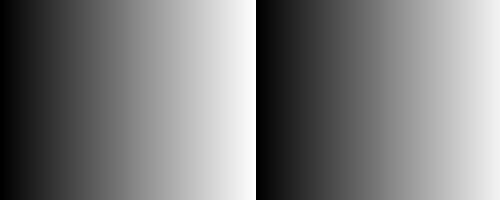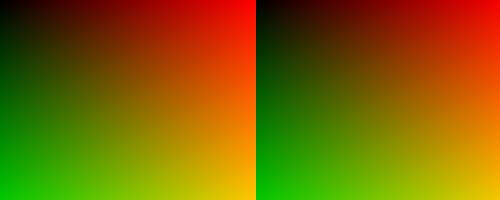golang中image包用法
image包實現了一個基本的2D影象庫,該包中包含基本的介面叫做image,這個裡面包含color,這個將在image/color中描述,
image介面的值建立方式有如下幾種:
1呼叫NewRGBA和NewPaletted
2解碼一個包含gif.jpen或者png格式的image資料的io.Reader
首先介紹一些image介面
type Image //image是一個從顏色模型中採取color.Color的矩形網格
任何一個struct只要實現了image中的三個方法,便實現了image介面type Image interface { ColorModel() color.Model //ColorModel 返回圖片的 color.Model Bounds() Rectangle //圖片中非0color的區域 At(x, y int) color.Color //返回指定點的畫素color.Color }
func Decode(r io.Reader) (Image, string, error) //Decode對一個根據指定格式進行編碼的圖片進行解碼操作,string返回的是在註冊過程中使用的格式化名字,如"gif"或者"jpeg"等.
func RegisterFormat(name, magic string, decode func(io.Reader) (Image, error), decodeConfig func(io.Reader) (Config, error))
RegisterFormat註冊一個image格式給解碼使用,name是格式化名字,例如"jpeg"或者"png",magic標明格式化編碼的字首,magic字串中能夠包含一個?字元,用來匹配任何一個字元,decode是用來解碼"編碼影象"的函式,DecodeConfig是一個僅僅解碼它的配置的函式.
type Alpha //用來設定圖片的透明度
type Alpha struct {
Pix []uint8 // Pix 儲存圖片的畫素 ,像 alpha 值. 在(X,Y)的畫素 starts at Pix[(y-Rect.Min.Y)*Stride + (x-Rect.Min.X)*1].
Stride int // Stride 表示垂直兩個畫素之間的步幅(距離)
Rect Rectangle // Rect 表示 圖片邊界.
}func NewAlpha(r Rectangle) *Alpha //利用給定矩形邊界產生一個alpha
func (p *Alpha) AlphaAt(x, y int) color.Alpha //獲取指定點的透明度
func (p *Alpha) At(x, y int) color.Color //獲取指定點的color(指定點的紅綠藍的透明度)
func (p *Alpha) Bounds() Rectangle //獲取alpha的邊界
func (p *Alpha) ColorModel() color.Model //獲取alpha的顏色模型
func (p *Alpha) Opaque() bool //檢查alpha是否完全不透明
func (p *Alpha) PixOffset(x, y int) int //獲取指定畫素相對於第一個畫素的相對偏移量
func (p *Alpha) Set(x, y int, c color.Color) //設定指定位置的color
func (p *Alpha) SetAlpha(x, y int, c color.Alpha) //設定指定位置的alpha
func (p *Alpha) SubImage(r Rectangle) Image //獲取p影象中被r覆蓋的子影象,父影象和子影象公用畫素
下面舉例說明其用法:
package main
import (
"fmt"
"image"
"image/color"
"image/jpeg"
"log"
"os"
)
const (
dx = 500
dy = 200
)
func main() {
file, err := os.Create("test.jpeg")
if err != nil {
log.Fatal(err)
}
defer file.Close()
alpha := image.NewAlpha(image.Rect(0, 0, dx, dy))
for x := 0; x < dx; x++ {
for y := 0; y < dy; y++ {
alpha.Set(x, y, color.Alpha{uint8(x % 256)}) //設定alpha圖片的透明度
}
}
fmt.Println(alpha.At(400, 100)) //144 在指定位置的畫素
fmt.Println(alpha.Bounds()) //(0,0)-(500,200),圖片邊界
fmt.Println(alpha.Opaque()) //false,是否圖片完全透明
fmt.Println(alpha.PixOffset(1, 1)) //501,指定點相對於第一個點的距離
fmt.Println(alpha.Stride) //500,兩個垂直畫素之間的距離
jpeg.Encode(file, alpha, nil) //將image資訊寫入檔案中
}
得到的圖形如下所示:
由於每種型別其方法類似,下面不再距離說明。
type Alpha16
type Alpha16 struct {
// Pix holds the image's pixels, as alpha values in big-endian format. The pixel at
// (x, y) starts at Pix[(y-Rect.Min.Y)*Stride + (x-Rect.Min.X)*2]. 大端模式,所以畫素計算和alpha不同
Pix []uint8
// Stride is the Pix stride (in bytes) between vertically adjacent pixels.
Stride int
// Rect is the image's bounds.
Rect Rectangle
}
func NewAlpha16(r Rectangle) *Alpha16
func (p *Alpha16) Alpha16At(x, y int) color.Alpha16
func (p *Alpha16) At(x, y int) color.Color
func (p *Alpha16) Bounds() Rectangle
func (p *Alpha16) ColorModel() color.Model
func (p *Alpha16) Opaque() bool
func (p *Alpha16) PixOffset(x, y int) int
func (p *Alpha16) Set(x, y int, c color.Color)
func (p *Alpha16) SetAlpha16(x, y int, c color.Alpha16)
func (p *Alpha16) SubImage(r Rectangle) Image
type Config //包括影象的顏色模型和寬高尺寸
type Config struct {
ColorModel color.Model
Width, Height int
}func DecodeConfig(r io.Reader) (Config, string, error)
type Gray //用來設定圖片的灰度
type Gray struct {
// Pix holds the image's pixels, as gray values. The pixel at
// (x, y) starts at Pix[(y-Rect.Min.Y)*Stride + (x-Rect.Min.X)*1].
Pix []uint8
// Stride is the Pix stride (in bytes) between vertically adjacent pixels.
Stride int
// Rect is the image's bounds.
Rect Rectangle
}func NewGray(r Rectangle) *Gray
func (p *Gray) At(x, y int) color.Color
func (p *Gray) Bounds() Rectangle
func (p *Gray) ColorModel() color.Model
func (p *Gray) GrayAt(x, y int) color.Gray
func (p *Gray) Opaque() bool
func (p *Gray) PixOffset(x, y int) int
func (p *Gray) Set(x, y int, c color.Color)
func (p *Gray) SetGray(x, y int, c color.Gray)
func (p *Gray) SubImage(r Rectangle) Image
type Gray16
type Gray16 struct {
// Pix holds the image's pixels, as gray values in big-endian format. The pixel at
// (x, y) starts at Pix[(y-Rect.Min.Y)*Stride + (x-Rect.Min.X)*2].
Pix []uint8
// Stride is the Pix stride (in bytes) between vertically adjacent pixels.
Stride int
// Rect is the image's bounds.
Rect Rectangle
}
func NewGray16(r Rectangle) *Gray16
func (p *Gray16) At(x, y int) color.Color
func (p *Gray16) Bounds() Rectangle
func (p *Gray16) ColorModel() color.Model
func (p *Gray16) Gray16At(x, y int) color.Gray16
func (p *Gray16) Opaque() bool
func (p *Gray16) PixOffset(x, y int) int
func (p *Gray16) Set(x, y int, c color.Color)
func (p *Gray16) SetGray16(x, y int, c color.Gray16)
func (p *Gray16) SubImage(r Rectangle) Image
type NRGBA
type NRGBA struct {
// Pix holds the image's pixels, in R, G, B, A order. The pixel at
// (x, y) starts at <span style="color:#FF0000;">Pix[(y-Rect.Min.Y)*Stride + (x-Rect.Min.X)*4]</span>.
Pix []uint8
// Stride is the Pix stride (in bytes) between vertically adjacent pixels.
Stride int
// Rect is the image's bounds.
Rect Rectangle
}func NewNRGBA(r Rectangle) *NRGBA
func (p *NRGBA) At(x, y int) color.Color
func (p *NRGBA) Bounds() Rectangle
func (p *NRGBA) ColorModel() color.Model
func (p *NRGBA) NRGBAAt(x, y int) color.NRGBA
func (p *NRGBA) Opaque() bool
func (p *NRGBA) PixOffset(x, y int) int
func (p *NRGBA) Set(x, y int, c color.Color)
func (p *NRGBA) SetNRGBA(x, y int, c color.NRGBA)
func (p *NRGBA) SubImage(r Rectangle) Image
type NRGBA64
type NRGBA64 struct {
// Pix holds the image's pixels, in R, G, B, A order and big-endian format. The pixel at
// (x, y) starts at Pix[(y-Rect.Min.Y)*Stride + (x-Rect.Min.X)*8].
Pix []uint8
// Stride is the Pix stride (in bytes) between vertically adjacent pixels.
Stride int
// Rect is the image's bounds.
Rect Rectangle
}
func NewNRGBA64(r Rectangle) *NRGBA64
func (p *NRGBA64) At(x, y int) color.Color
func (p *NRGBA64) Bounds() Rectangle
func (p *NRGBA64) ColorModel() color.Model
func (p *NRGBA64) NRGBA64At(x, y int) color.NRGBA64
func (p *NRGBA64) Opaque() bool
func (p *NRGBA64) PixOffset(x, y int) int
func (p *NRGBA64) Set(x, y int, c color.Color)
func (p *NRGBA64) SetNRGBA64(x, y int, c color.NRGBA64)
func (p *NRGBA64) SubImage(r Rectangle) Image
type Paletted
type Paletted struct {
// Pix holds the image's pixels, as palette indices. The pixel at
// (x, y) starts at Pix[(y-Rect.Min.Y)*Stride + (x-Rect.Min.X)*1].
Pix []uint8
// Stride is the Pix stride (in bytes) between vertically adjacent pixels.
Stride int
// Rect is the image's bounds.
Rect Rectangle
// Palette is the image's palette. 圖片的調色盤
Palette color.Palette
}func NewPaletted(r Rectangle, p color.Palette) *Paletted //根據指定的寬高和顏色調色盤生成一個新的調色盤
func (p *Paletted) At(x, y int) color.Color
func (p *Paletted) Bounds() Rectangle
func (p *Paletted) ColorIndexAt(x, y int) uint8
func (p *Paletted) ColorModel() color.Model
func (p *Paletted) Opaque() bool
func (p *Paletted) PixOffset(x, y int) int
func (p *Paletted) Set(x, y int, c color.Color)
func (p *Paletted) SetColorIndex(x, y int, index uint8)
func (p *Paletted) SubImage(r Rectangle) Image
type PalettedImage //調色盤影象介面
type PalettedImage interface {
ColorIndexAt(x, y int) uint8 //返回在位置(x,y)處畫素的索引
Image //image介面
}
type Point //一個點的(x,y)座標對
type Point struct {
X, Y int
}
func Pt(X, Y int) Point //Pt是Point{X, Y}的簡寫
func (p Point) Add(q Point) Point //兩個向量點求和
func (p Point) Div(k int) Point //Div returns the vector p/k,求Point/k的值
func (p Point) Eq(q Point) bool //判定兩個向量點是否相等
func (p Point) In(r Rectangle) bool //判斷某個向量點是否在矩陣中
func (p Point) Mod(r Rectangle) Point //在矩陣r中求一個點q,是的p.x-q.x是矩陣寬的倍數,p.y-q.y是矩陣高的倍數
func (p Point) Mul(k int) Point //返回向量點和指定值的乘積組成的向量點
func (p Point) String() string //返回用string表示的向量點,其樣式如(1,2)
func (p Point) Sub(q Point) Point //兩個向量點求差
舉例說明如下:
func main() {
pt := image.Point{X: 5, Y: 5}
fmt.Println(pt) //(5,5) ,輸出一個點位置(X,Y)
fmt.Println(image.Pt(1, 2)) //(1,2) ,Pt輸出一個點位置的簡寫形式
fmt.Println(pt.Add(image.Pt(1, 1))) //(6,6),兩個點求和
fmt.Println(pt.String()) //(5,5) ,以字串形式輸出點
fmt.Println(pt.Eq(image.Pt(5, 5))) //true,判斷兩個點是否完全相等
fmt.Println(pt.In(image.Rect(0, 0, 10, 10))) //true,判斷一個點是否在矩陣中
fmt.Println(pt.Div(2)) //(2,2),求點的商
fmt.Println(pt.Mul(2)) // (10,10),求點的乘積
fmt.Println(pt.Sub(image.Pt(1, 1))) // (4,4),求兩個點的差fmt.Println(pt.Mod(image.Rect(9, 8, 10, 10))) // (9,9),dx=10-9=1,dy=10-8=2,9-5=4,4是1和2的倍數並且(9,9)在矩陣中
}type RGBA
type RGBA struct {
// Pix holds the image's pixels, in R, G, B, A order. The pixel at
// (x, y) starts at Pix[(y-Rect.Min.Y)*Stride + (x-Rect.Min.X)*4]
Pix []uint8
// Stride is the Pix stride (in bytes) between vertically adjacent pixels.
Stride int
// Rect is the image's bounds.
Rect Rectangle
}func NewRGBA(r Rectangle) *RGBA
func (p *RGBA) At(x, y int) color.Color
func (p *RGBA) Bounds() Rectangle
func (p *RGBA) ColorModel() color.Model
func (p *RGBA) Opaque() bool
func (p *RGBA) PixOffset(x, y int) int
func (p *RGBA) Set(x, y int, c color.Color)
func (p *RGBA) SetRGBA(x, y int, c color.RGBA)
func (p *RGBA) SubImage(r Rectangle) Image
舉例說明RGBA用法:
package main
import (
"fmt"
"image"
"image/color"
"image/jpeg"
"log"
"os"
)
const (
dx = 500
dy = 200
)
func main() {
file, err := os.Create("test.jpg")
if err != nil {
log.Fatal(err)
}
defer file.Close()
rgba := image.NewRGBA(image.Rect(0, 0, dx, dy))
for x := 0; x < dx; x++ {
for y := 0; y < dy; y++ {
rgba.Set(x, y, color.NRGBA{uint8(x % 256), uint8(y % 256), 0, 255})
}
}
fmt.Println(rgba.At(400, 100)) //{144 100 0 255}
fmt.Println(rgba.Bounds()) //(0,0)-(500,200)
fmt.Println(rgba.Opaque()) //true,其完全透明
fmt.Println(rgba.PixOffset(1, 1)) //2004
fmt.Println(rgba.Stride) //2000
jpeg.Encode(file, rgba, nil) //將image資訊存入檔案中
}得到的檔案如下;
type RGBA64
type RGBA64 struct {
// Pix holds the image's pixels, in R, G, B, A order and big-endian format. The pixel at
// (x, y) starts at Pix[(y-Rect.Min.Y)*Stride + (x-Rect.Min.X)*8].
Pix []uint8
// Stride is the Pix stride (in bytes) between vertically adjacent pixels.
Stride int
// Rect is the image's bounds.
Rect Rectangle
}func NewRGBA64(r Rectangle) *RGBA64
func (p *RGBA64) At(x, y int) color.Color
func (p *RGBA64) Bounds() Rectangle
func (p *RGBA64) ColorModel() color.Model
func (p *RGBA64) Opaque() bool
func (p *RGBA64) PixOffset(x, y int) int
func (p *RGBA64) RGBA64At(x, y int) color.RGBA64
func (p *RGBA64) Set(x, y int, c color.Color)
func (p *RGBA64) SetRGBA64(x, y int, c color.RGBA64)
func (p *RGBA64) SubImage(r Rectangle) Image
type Rectangle //利用兩個座標點來生成矩陣
type Rectangle struct {
Min, Max Point
}func Rect(x0, y0, x1, y1 int) Rectangle //Rect是Rectangle{Pt(x0, y0), Pt(x1, y1)}的一種簡寫形式
func (r Rectangle) Add(p Point) Rectangle //矩陣中兩個點都與指定的點求和組成一個新的矩陣
func (r Rectangle) Canon() Rectangle //返回標準格式的矩形,如果有必要的話,會進行最小值座標和最大座標的交換
func (r Rectangle) Dx() int //返回矩陣寬度dx
func (r Rectangle) Dy() int //返回矩陣高度dy
func (r Rectangle) Empty() bool //判定是否該矩陣為空,即不包含任何point
func (r Rectangle) Eq(s Rectangle) bool //判斷兩個矩陣是否相等,指的是完全重合
func (r Rectangle) In(s Rectangle) bool //判斷一個矩陣是否在另外一個矩陣之內
func (r Rectangle) Inset(n int) Rectangle //返回根據n算出的嵌入的矩陣,計算方法是矩陣的每個座標都減去n,求得的矩陣必須在已知矩陣內嵌,如果沒有的話則返回空矩陣
func (r Rectangle) Intersect(s Rectangle) Rectangle //求兩個矩陣的相交矩陣,如果兩個矩陣不相交,則返回0矩陣
func (r Rectangle) Overlaps(s Rectangle) bool //判斷兩個矩陣是否有交集,即判斷兩個矩陣是否有公共區域
func (r Rectangle) Size() Point //返回矩陣的寬和高,即dx和dy
func (r Rectangle) String() string //返回矩陣的字串表示
func (r Rectangle) Sub(p Point) Rectangle //一個矩陣的兩個座標點同時減去一個指定的座標點p,得到的一個新的矩陣
func (r Rectangle) Union(s Rectangle) Rectangle //兩個矩陣的並集,這個是和Intersect(求兩個矩陣的交集)相對的
舉例說明Rectangle用法:
package main
import (
"fmt"
"image"
)
func main() {
rt := image.Rect(0, 0, 100, 50)
rt1 := image.Rect(100, 100, 10, 10)
fmt.Println(rt1.Canon()) //(10,10)-(100,100),rt1大小座標交換位置
fmt.Println(rt, rt1) //(0,0)-(100,50) (10,10)-(100,100)
fmt.Println(rt.Dx(), rt.Dy()) //100 50,返回矩陣的寬度和高度
fmt.Println(rt.Empty()) //false,矩陣是否為空
fmt.Println(rt.Eq(rt1)) //false,兩個矩陣是否相等
fmt.Println(rt.In(rt1)) //false,矩陣rt是否在矩陣rt1中
fmt.Println(rt.Inset(10)) //(10,10)-(90,40),查詢內嵌矩陣,用原矩陣座標點減去給定的值10得到的矩陣,該矩陣必須是原矩陣的內嵌矩陣
if rt.Overlaps(rt1) {
fmt.Println(rt.Intersect(rt1)) //(10,10)-(100,50) //求兩個矩陣的交集
}
fmt.Println(rt.Size()) //(100,50),求矩陣大小,其等價與(dx,dy)
fmt.Println(rt.String()) // (0,0)-(100,50)
fmt.Println(rt.Sub(image.Pt(10, 10))) // (-10,-10)-(90,40),求矩陣和一個點的差,用於將矩陣進行移位操作
fmt.Println(rt.Union(rt1)) //(0,0)-(100,100),求兩個矩陣的並集
}type Uniform //Uniform是一個具有統一顏色無窮大小的圖片,它實現了color.Color, color.Model, 以及 Image的介面
type Uniform struct {
C color.Color
}func NewUniform(c color.Color) *Uniform //根據color.Color產生一個Uniform
func (c *Uniform) At(x, y int) color.Color //獲取指定點的畫素資訊
func (c *Uniform) Bounds() Rectangle //獲取影象的邊界矩陣資訊
func (c *Uniform) ColorModel() color.Model //獲取影象的顏色模型
func (c *Uniform) Convert(color.Color) color.Color //將圖片的畫素資訊轉換為另外一種指定的畫素資訊
func (c *Uniform) Opaque() bool //判定圖片是否完全透明
func (c *Uniform) RGBA() (r, g, b, a uint32) //返回圖片的r,g,b,a(紅,綠,藍,透明度)的值
type YCbCr //YCbCr是一個Y'CbCr顏色的圖片,每個Y樣本表示一個畫素,但是每個Cb和Cr能夠代表一個或者更多的畫素,YStride是在相鄰垂直畫素的Yslice索引增 //量,CStride是Cb和 Cr slice在相鄰垂直畫素(對映到獨立色度取樣)的索引增量.通常YStride和len(Y)是8的倍數,而CStride結果如下:
For 4:4:4, CStride == YStride/1 && len(Cb) == len(Cr) == len(Y)/1. For 4:2:2, CStride == YStride/2 && len(Cb) == len(Cr) == len(Y)/2. For 4:2:0, CStride == YStride/2 && len(Cb) == len(Cr) == len(Y)/4. For 4:4:0, CStride == YStride/1 && len(Cb) == len(Cr) == len(Y)/2.
type YCbCr struct {
Y, Cb, Cr []uint8
YStride int
CStride int
SubsampleRatio YCbCrSubsampleRatio
Rect Rectangle
}func NewYCbCr(r Rectangle, subsampleRatio YCbCrSubsampleRatio) *YCbCr //通過給定邊界和子樣本比例建立新的YCbCr
func (p *YCbCr) At(x, y int) color.Color //獲取指定點的畫素
func (p *YCbCr) Bounds() Rectangle //獲取影象邊界
func (p *YCbCr) COffset(x, y int) int //獲取指定點相對於第一個Cb元素的畫素點的相對位置
func (p *YCbCr) ColorModel() color.Model //獲取顏色Model
func (p *YCbCr) Opaque() bool //判定是否完全透明
func (p *YCbCr) SubImage(r Rectangle) Image //根據指定矩陣獲取原影象的子影象
func (p *YCbCr) YCbCrAt(x, y int) color.YCbCr
func (p *YCbCr) YOffset(x, y int) int //獲取相對於第一個Y元素的畫素點的相對位置
type YCbCrSubsampleRatio //YCbCr的色度子樣本比例,常用於NewYCbCr(r Rectangle, subsampleRatio YCbCrSubsampleRatio)中用來建立YCbCr
const (
YCbCrSubsampleRatio444 YCbCrSubsampleRatio = iota
YCbCrSubsampleRatio422
YCbCrSubsampleRatio420
YCbCrSubsampleRatio440
)func (s YCbCrSubsampleRatio) String() string //YCbCrSubsampleRatio結構的字串表示


